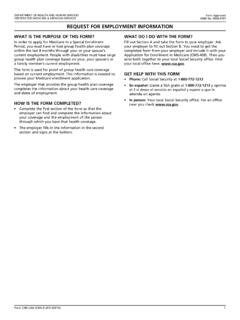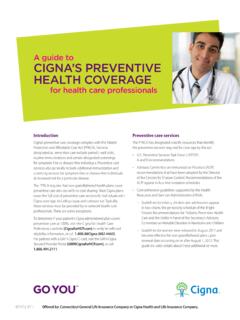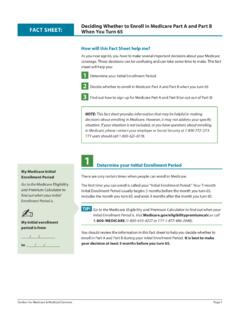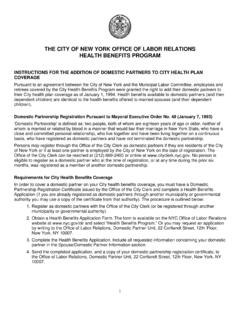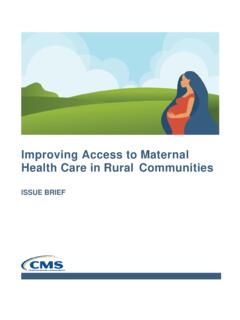Transcription of DEPARTMENT OF THE TREASURY - IRS tax forms
1 1[4830-01-u] DEPARTMENT OF THE TREASURYI nternal Revenue Service26 CFR Part 1[TD 8878 ]RIN 1545-AU61 Tax Treatment of Cafeteria PlansAGENCY: Internal Revenue Service (IRS), : Final : This document contains final regulations relating to section 125 cafeteriaplans. The final regulations clarify the circumstances under which a section 125cafeteria plan election may be changed. The final regulations permit an employer toallow a section 125 cafeteria plan participant to revoke an existing election and make anew election during a period of coverage for accident or health coverage or group-termlife insurance coverage . DATES: Effective Date: These regulations are effective March 23, Date: These regulations are applicable for cafeteria plan yearsbeginning on or after January 1, 2001. See the Scope of Regulations and EffectiveDate portion of this preamble. The following are not qualified benefits: products advertised, marketed, or1offered as long-term care insurance; medical savings accounts under section 106(b);qualified scholarships under section 117; educational assistance programs undersection 127; and fringe benefits under section FURTHER INFORMATION CONTACT: Janet A.
2 Laufer or Christine L. Keller at(202) 622-6080 (not a toll-free number).SUPPLEMENTARY INFORMATION:BackgroundThis document contains amendments to the Income Tax Regulations (26 CFRpart 1) under section 125. Section 125 generally provides that an employee in acafeteria plan will not have an amount included in gross income solely because theemployee may choose among two or more benefits consisting of cash and "qualifiedbenefits." A qualified benefit generally is any benefit that is excludable from grossincome under an express provision of the Internal Revenue Code, including coverageunder an employer-provided accident or health plan under sections 105 and 106,group-term life insurance under section 79, elective contributions under a qualifiedcash or deferred arrangement within the meaning of section 401(k), dependent careassistance under section 129, and adoption assistance under section 137. Qualified1benefits can be provided under a cafeteria plan either through insured arrangements orarrangements that are not insured.
3 49 FR 19321 (May 7, 1984) and 54 FR 9460 (March 7, 1989), Those proposed regulations contain special rules with respect to flexible3spending arrangements. A flexible spending arrangement (FSA) is defined in section106(c)(2). Under section 106(c)(2), an FSA is generally a benefit program under whichthe maximum reimbursement reasonably available for coverage is less than 500% ofthe value of the coverage . 62 FR 60196 (November 7, 1997) and 62 FR 60165 (November 7, 1997),4respectively. IRS Announcement 98-105 (1998-49 21 (November 23, 1998))states that the Service will amend the effective date of those proposed and temporaryregulations so that they will not be effective before plan years beginning at least 120days after further guidance is 1984 and 1989, proposed regulations were published relating to theadministration of cafeteria plans. In general, the 1984 and 1989 proposed regulations2require that for benefits to be provided on a pre-tax basis under section 125, anemployee may make changes during a plan year only in certain circumstances.
4 3 Specifically, Q&A-8 of ' and Q&A-6(b), (c), and (d) of ' permitparticipants to make benefit election changes during a plan year pursuant to changesin cost or coverage , changes in family status, and separation from 1997, temporary and proposed regulations were issued addressing thestandards under which a cafeteria plan may permit a participant to change his or hergroup health coverage election during a period of coverage to conform with the specialenrollment rights under section 9801(f) (added to the Internal Revenue Code by theHealth Insurance Portability and Accountability Act of 1996 (HIPAA)) and to change hisor her group health or group-term life insurance coverage in a variety of change instatus situations. 44 These final regulations, which replace the 1997 temporary regulations, clarifythe circumstances under which a cafeteria plan may permit an employee to revoke anexisting election with respect to accident or health coverage , or group-term lifeinsurance coverage , and make a new election during a period of coverage .
5 Explanation of ProvisionsA. regulations clarify the circumstances under which a cafeteria plan maypermit an employee to change his or her cafeteria plan election with respect to accidentor health coverage or group-term life insurance coverage during the plan year. Theregulations generally follow the existing temporary regulations, and include a variety ofexamples illustrating how the rules apply in specific final regulations include two principal changes that have been made inresponse to public comments. First, the regulations differ from the 1997 regulationswith respect to change in status events resulting from a change in employment. Commentators requested a loosening of the rules regarding when a cafeteria planelection can be changed. In response, the final rules incorporate a more flexible ruleunder which any change in the employment status of the employee (or a spouse ordependent of the employee) that affects that individual=s eligibility under a cafeteriaplan or qualified benefits plan constitutes a change in status for purposes of permittinga mid-year election change.
6 Second, in the event of a change in an employee=s marital5status or the employment status of the employee=s spouse or dependent, the finalregulations permit the employee to elect either to increase group-term life insurancecoverage or to decrease group-term life insurance coverage . A similar rule applies withrespect to disability income final regulations were developed as part of an integrated package withproposed regulations that are being published elsewhere in this issue of the FederalRegister. Those proposed regulations provide guidance on election changes onaccount of changes in status with respect to dependent care assistance and adoptionassistance and provide guidance on election changes on account of changes in cost orcoverage with respect to dependent care assistance, adoption assistance, accident orhealth coverage , and group-term life insurance coverage . The integrated package offinal and proposed regulations is intended to provide clear standards for planadministration and for administration of the tax law.
7 The standards are designed toaccommodate the most common types of events of independent significance that donot occur on a regular, periodic basis and that are likely to affect an employee=sdecisions with respect to qualified benefits Changes in on the 1997 temporary and proposed regulations requested thatthe description of changes in status be expanded to include work-related changes of anemployee, the employee=s spouse, or the employee=s dependent in addition to6termination or commencement of employment or change in worksite. In response tothese comments, the description of changes in status has been broadened to include astrike or lockout, and a commencement of or return from an unpaid leave of absence. In addition, the final rules incorporate a more flexible rule for other change inemployment status events. Specifically, if there is a change in the employment statusof the employee (or a spouse or dependent of the employee) that affects thatindividual=s eligibility under a cafeteria plan or qualified benefits plan, then that changeconstitutes a change in status.
8 For example, if an employee switches from salaried tohourly-paid status, resulting in the employee ceasing to be eligible for coverage underthe plan, then that change constitutes a change in commentators expressed concern that the 1997 temporary and proposedregulations did not permit an employee to make an election change to cover additionalindividuals under an accident or health plan when an employer changed its policy ( ,to permit coverage for a parent or for a domestic partner pursuant to local lawrequirements). Under the 1997 temporary and proposed regulations, a change instatus includes an event that causes an employee=s dependent to satisfy or cease tosatisfy the eligibility requirements for coverage under a plan. Thus, if an individual whois a dependent of an employee becomes eligible for coverage under the employer=shealth plan as a result of an amendment made to the plan during the year, that is achange in status event and, accordingly, the cafeteria plan may permit an election Alternatively, the cafeteria plan may prohibit an employee from participating in the5cafeteria plan for that plan year upon reemployment.
9 7change by the employee to cover the individual. These final regulations retain the rulefrom the 1997 temporary and proposed final regulations do not address when a bona fide termination ofemployment occurs. However, these regulations retain the example (Example 8 underparagraph (c)(4) of these final regulations) from the 1997 temporary and proposedregulations addressing the situation in which an employee terminates and resumesemployment within 30 days. The effect of this example is to provide a practical safeharbor that generally may be applied by cafeteria plans without regard to other factsand circumstances. Under this example, if an employee terminates and resumesemployment within 30 days and the cafeteria plan provides that the employee=s electionis automatically reinstated, the employer is not required to determine whether a bonafide change in status has occurred with respect to termination of employment.
10 Conversely, the cafeteria plan may permit an employee who resumes employmentmore than 30 days following termination to be automatically reinstated to the priorelection or to make a new election. 5C. Consistency under the 1997 temporary and proposed regulations, the final regulationsrequire that an election change as a result of a change in status also satisfy aconsistency requirement. In response to comments, the final regulations expand and8clarify the consistency requirement with respect to change in status events for group-term life insurance. Under the 1997 regulations, in the case of a commencement ofemployment, marriage, birth, adoption, or placement for adoption, an employee couldelect to increase (but not decrease) group-term life insurance coverage . The 1997regulations also permitted an employee to elect to decrease (but not to increase)group-term life insurance coverage in the case of divorce, legal separation, annulment,or death of a spouse or dependent.










